
“The pair of shoes found in the city of Palmyra, Syria, dates back 2,000 years.
The discovery of a 2,000-year-old pair of Roman children’s shoes in the ruins of Palmyra provides valuable historical context for both the ancient city and the wider Roman Empire. Palmyra, located in present-day Syria, was a flourishing oasis city on the Silk Road, serving as a vital hub for trade and culture.
During the Roman period, which spanned from the 1st century BCE to the 3rd century CE, Palmyra experienced significant prosperity and emerged as an important regional power. The city thrived under Roman rule, benefiting from its strategic location and favorable economic conditions. Palmyrene merchants engaged in extensive trade, connecting the Mediterranean world with the East, granting the city a cosmopolitan character and great wealth.
The discovery of children’s shoes offers a glimpse into the daily life and material culture of Palmyra’s inhabitants during this time. Footwear was an essential part of life for both children and adults, providing protection and comfort while navigating the ancient streets and engaging in daily activities. By examining these shoes, archaeologists can gain insights into the design of ancient Roman footwear, the materials used, and the craftsmanship of the period.
Moreover, this find underscores the lasting archaeological significance of Palmyra, whose ruins—including the famous Temple of Bel, the Arch of Triumph, and the Valley of the Tombs—have long captivated explorers, scholars, and historians. Unfortunately, Palmyra has faced severe threats in recent years due to the ongoing conflict in Syria. The discovery of well-preserved artifacts, such as Roman children’s shoes, highlights the importance of preserving and protecting cultural heritage sites during times of unrest.
Studying these shoes within the broader historical context of the Roman Empire enables historians to reconstruct aspects of daily life, fashion, and social customs from that era. It also provides evidence of the interconnectedness of ancient civilizations and the enduring influence of Roman culture in regions far beyond Italy.

The Palmyrene Empire in 271 AD.
Discover more from History in Pictures
Subscribe to get the latest posts sent to your email.